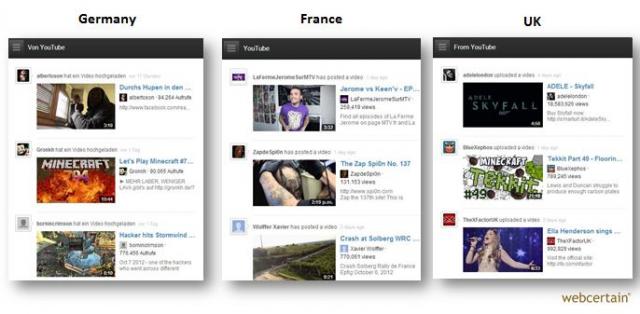A year ago, YouTube invested a reported $150 million in 100 US-based YouTube channels (either brand new or existing channels) in a move to make its site look less amateurish and, in essence, more like TV.
And the world’s top online video site is following through with this strategy, as it recently announced it will invest in an additional 60+ channels, some of which will have content specifically crafted for either German, French or UK audiences.
YouTube already has local partnerships and ad sales in more than 40 countries worldwide, but this is the site’s first international push where it’s putting money at risk to catalyse the creation of high quality localised content for some of its top global markets. This is further testament to YouTube’s incremental localisation of its site.
Think of YouTube as a “car on the freeway”
The channel experiment is part of YouTube’s overall monetisation strategy. In an interview with Peter Kafka from All Things D, YouTube Channel Guide Robert Kyncl referred to the strategy of the video site as a “car on the freeway”:
- 1st gear: YouTube.com launches in 2005 as a generic version available everywhere in the world.
- 2nd gear: YouTube acknowledges the potential of localising its service and sets up the aforementioned local partnerships and ad sales arrangements.
- 3rd gear: Channel deals with either new or existing partners in markets/countries with high monetisation potential. Typically 1-year contracts which will then be up for renewal or rejection once the year has passed.YouTube’s advance payments are interest-free, but the Google-owned video behemoth clears all ad revenues generated by the channel until the initial investment has been covered. From thereon after the two parties will split revenues. France, Germany and the UK are the first international countries to reach this phase.
- 4th gear: Whereas “gear three” was available to both existing and new partners, this step will be exclusively for existing partners who are already successful on YouTube. According to Robert Kyncl, these channel partners will be offered greater revenue predictability and longer-term contracts. However, nothing has yet been formalised and could take a different shape, Kyncl further adds in the interview.
- 5th gear: This steady move towards higher quality content will improve monetisation, benefiting not only YouTube (Google) but channel owners with a large following. In this regard, head of YouTube Salar Kamangar recently said: “If you see a dog on a skateboard video, the CPMs, the cost per thousand impressions, are about $2. Now, if you package that as part of a dog lover’s channel or a skateboarding interest channel, that same video can command a $20 CPM.”
Ultimately, as advertising revenues rise, YouTube expects to pull quality publishers to the video platform without having to offer any financial incentives.
Certainly, it’s still way too early to conclude whether this is going to be a successful path for YouTube, although the video site has already cleared its original $150 million investment due to the higher ad rates given to professional content and increased viewership.
If YouTube’s investment in France, Germany and UK yields similar results to its first batch, it wouldn’t be surprising to see the company expanding its channel programme further in the near future.
Super Early Bird Rates for the International Social Media Summit @SMX Social in Las Vegas Expire Saturday 13th October. Book now.








